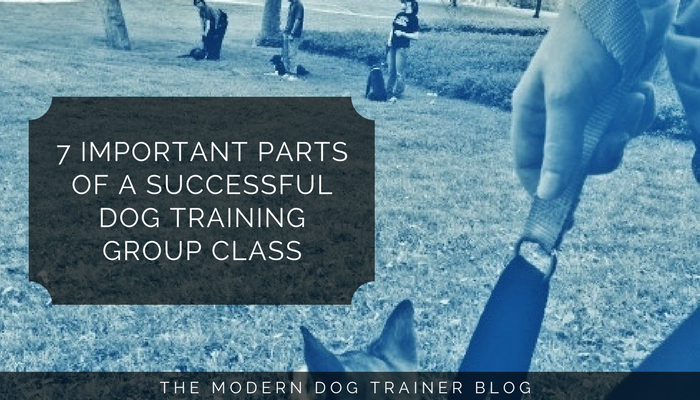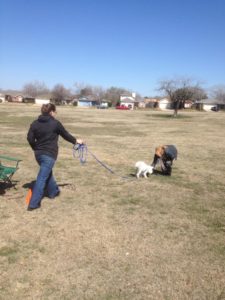 Group dog training classes are one of the most popular ways that dog trainers interact with their clients. Group classes allow past clients to come back to refresh their skills, new clients to get started in basic dog training, and for private lesson clients to grow their skills and their dog’s skills around more distractions.
Group dog training classes are one of the most popular ways that dog trainers interact with their clients. Group classes allow past clients to come back to refresh their skills, new clients to get started in basic dog training, and for private lesson clients to grow their skills and their dog’s skills around more distractions.
There are a variety of group classes you could hold. Some dog trainers start with basic puppy and obedience classes then progress to group tricks classes or
Why Teach Group Dog Training Classes?
Group classes help owners receive dog training help at a reduced cost since group classes are typically less expensive than private, one-to-one lessons. Classes also allow your clients to meet others in their situation which is great when they are struggling and need some encouragement. As a dog trainer holding group classes, you have the power to reach many more people and you can work to create a real, connected community to help you build a successful, sustainable dog training business.
When you’re first starting out, some important pieces of a great group class may elude you. Unless you’ve observed a mentor or taken a group class yourself (and perhaps even if you have), you may not be aware of some of the critical aspects of a successful dog training group class. Here are some recommendations to help you make it the best experience possible for your students.
1. Initial Written Expectations
Start by thinking about what your clients want to get out of the class. What do they want to be able to do with their dogs? Put clear expectations about what will be expected of them to achieve this result. In a welcome email, you can include information about where the class will be held, when you’ll meet, what they should bring, and you could even go into specifics such as how they should enter or exit the room to avoid dog-dog confrontations. The more detailed and specific you are, the more organized you’ll appear and the more prepared your clients will be.
(Related Article: How to Prevent Overwhelm and Increase Compliance in New Dog Training Clients)
You’ll want to send out expectations via email a couple of times before the class begins. I would never expect someone to read an email I send out less than 48hours before a class. You can also request a reply to your email to confirm all the students have received it and it didn’t end up in their spam folder. If you request a reply and don’t receive one, follow up with a phone call to make sure they read the instructions and are aware that you’ll be sending communication via email.
2. Space
Find a space for your group dog training classes that will help dogs and their owners feel safe and comfortable. Think about ways you can improve the level of comfort in the class. Should you offer chairs? Should you ask students to bring a non-slip mat for their dogs? Should you bring visual barriers to help dogs keep calm?
Control the space your students are occupying by placing markers or barriers between them to make sure everyone stays at a safe distance from each other.
3. Curriculum
When deciding on your curriculum, consider your student’s experience. Will students in your class know the mechanical skills required to train their dogs already? Do they know what positive reinforcement is and how it works? If not, you’ll want to have a sort of orientation to get your students acquainted with how dogs learn, dog body language, what is and isn’t realistic when it comes to their behavior, and more. Once your students understand the way they’ll be training, then you can coach them on how to utilize this information to train their own dogs.
There are hundreds of choices when it comes to group class curriculum. You can create your own from scratch or collaborate with other trainers that are willing to share what they have.
A fairly common curriculum I’ve seen is Sue Ailsby’s Training Levels Program. The first few levels are a great starting point for basic obedience and dog sports.
For reactive dog classes, I’d strongly recommend reading Emma Parson’s book, “Teaching the Reactive Dog Class: Leading the Journey from Reactivity to Reliability.“
You can hold
4. Confidence
 Make sure you are confident enough to speak in front of a few other people and lead them through the steps of the curriculum.
Make sure you are confident enough to speak in front of a few other people and lead them through the steps of the curriculum.
Project your voice. Have the confidence to let your voice be heard. You know more about dogs and dog training than anyone else in the room. Your students have already invested their time and money to listen to you speak so
Step in when a student is struggling. A group class should always have a few minutes of one-to-one attention so that each student can be successful. Step in when you see a student getting frustrated or annoyed at their dog before things escalate too much.
Ask students to listen. If you have any chatty-Cathys in your class or children that are being disruptive, do not be afraid to redirect their attention for the sake of the whole class. Other students appreciate it when the
Let people know when they should be listening and when they should be practicing with a signal. You can even use a visual (red light/green light card) or an audible bell to let people know when to begin otherwise some may get distracted or start practicing before you’re done instructing. This signal only improves communication and expectations.
5. Games
If your students are starting to master the material, have a few games up your sleeve to increase the difficulty and level of fun. There’s a book with many different games you can play in your group dog training classes called “Gamify Your Dog Training” by Terry Ryan.
6. Community
In
7. Next Steps For Students
Part of creating a great experience for your students is having a clear next-step to take with their dog so that they aren’t left without direction. Take the lead and introduce some possible next steps for your group class graduates. Will you offer a Level 2? A class with more games or even a beginner dog
Offering ongoing services either in group form or private lesson form is important to maintain your income as a dog trainer. Many people, including me when I first started out, rarely work with clients again after their initial goals have been met. How can you position your services to help your clients maintain their dog’s training while you continue to generate income over time for your business?



